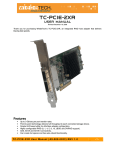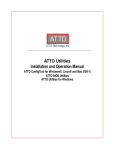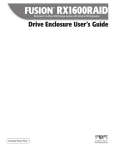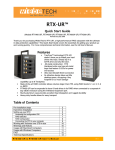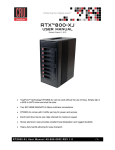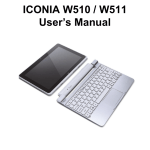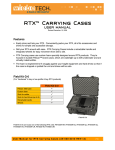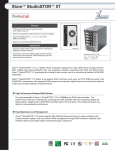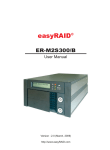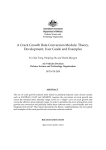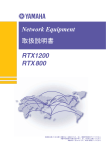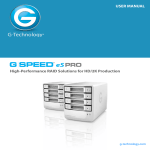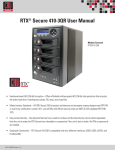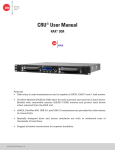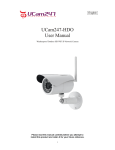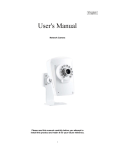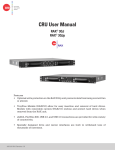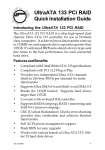Download A9-800-0003 Revision 1.0 RTX800-TR User Manual
Transcript
CRU RTX® 800-TR User Manual Features • Supports JBOD and RAID levels 0, 1, 4, 5, 6, and 10 in hardware, with easy configuration using ATTO Technology’s RAID management software. • C RU TrayFree™ bays make adding drives effortless: simply open a drive bay door, slide the drive in, and close the door. No screws, no trays, no tools. The rugged TrayFree bays are rated for over tens of thousands of insertions. • P rovides up to 32TB of storage for video editing, visualization, simulation, highcapacity storage, or backups of large amounts of data. • D ual Thunderbolt interfaces allow the fastest connection to your Mac or PC host, at rates up to 10 Gbps in both directions and at the same time. This kind of performance can transfer or back up 1TB of content in approximately 20 minutes. A9-800-0003 Revision 1.0 Table of Contents 1. Pre-Installation Steps 1.1 Box Contents 1.2 Identifying Parts of your RTX800-TR 1.3 Warnings and Notices 1. Pre-Installation Steps 2 2 2 2 2. Introduction to RAID 3 2.1 Summary of RAID Levels 3. Installation Steps 3.1 Hard Drive Installation 3.2 Operating Your RTX Enclosure 3.2.1 Installing Thunderbolt Drivers 3.2.2 Install ATTO ConfigTool 3.2.3 Configuring RAID 4. Customizing a RAID Setup 5. Configuring Drive Redundancy 3 3 3 3 4 4 4 5 5 5.1 Create a Hot Spare Pool 5 5.2 Enable Auto-Rebuild 6 6. Change RAID Group Properties 6 7. Recovering From A Failed Hard Drive or RAID Group 6 7.1 Rebuilding the RAID Group 7 7.1.2 Manual Replacement 7 7.1.3 Recovery from Replacement of a Wrong Drive 7 7.2 Data Recovery 7 8. RAID Notifications 8 8.1 Configuring Visual, Audible, and System Log Alerts 8 8.2 Configuring E-Mail Notifications 8 8.3 Retrieving System Logs 9 9.1 Usage with Mac OS X Accessories Quantity RTX800-TR Enclosure 1 Thunderbolt Cable 1 Power Cord 1 Quick Start Guide 1 1.2 Identifying Parts of your RTX800-TR Drive Power and Activity LEDs TrayFree Bay 7 7.1.1 Automatic Replacement 9. Usage with Mac and Windows Operating Systems 1.1 Box Contents The following list contains the items that are included in the complete configuration for this device. Please contact CRU if any items are missing or damaged: 9 Ejection Handle Thunderbolt Ports Cooling Fans 9 9.1.1 Formatting the RAID Group 9 9.1.2 Mounting and Unmounting Volumes 9 9.2 Usage with Windows Operating Systems 9 9.2.1 Formatting the RAID Group 9 9.2.2 Mounting and Unmounting Volumes 10 10. RAID is Not A Backup 10 11. Technical Specifications 11 Power Switch Power Port 1.3 Warnings and Notices Please read the following before beginning installation. General Care • Proper grounding is strongly recommended to prevent electrical damage to the enclosure or other connected devices, including the computer Page 2 CRU Mark 10.25.12 PMS 711 2 cyan host. Avoid all dramatic movement, tapping on the unit, and vibration. • • • Before starting any type of hardware installation, please ensure that all power switches have been turned off and all power cords have been disconnected to prevent personal injury and damage to the hardware. To avoid overheating, the RTX enclosure should be operated in a well-ventilated area. Remove the drives before transporting the RTX enclosure to prevent damage to the drive interfaces. RAID • Use only hard drives that are in perfect condition. Avoid using drives that have ever developed bad sectors during previous use. This could lead to possible device failure or loss of data. • • • The RTX enclosure supports SATA hard drives of various specifications and different capacities. However, we recommend using drives of the same brand and type across all bays for optimal performance. If drives of different capacities are used in a RAID, the capacity of the smallest drive will determine how much of each drive is used. The additional capacity on the larger drives will not be used by the RAID. RAID level 0 will allow you to use the full combined capacity of the drives and offers the best data transfer speeds. However, RAID 0 offers no protection for the data. If one drive fails in a RAID 0, the data on all of the drives is irretrievably lost. Before creating a RAID, investigate the various RAID types and choose the one that is best for your needs. Always back up data before switching RAID types. Switching RAID types will destroy current data. You must reformat your drives afterwards. 2 Introduction to RAID A RAID (Redundant Array of Independent Disks) is an array of multiple hard drives that are combined in a way that provides faster performance and/or data safety. Your RTX enclosure is capable of creating and managing several different varieties of RAID. You may choose your preferred RAID level based on factors such as disk capacity, desired data safety, and desired performance. 2.1 Summary of RAID Levels The RTX enclosure supports RAID Levels JBOD, 0, 1, 4, 5, 6, 10, and a custom RAID mode called ATTO DVRAID™. RAID Level 5 is most commonly used by those seeking an optimal balance of speed and data safety, however ATTO DVRAID is optimized for applications such as video production that require a high data transfer rate. Page 3 RAID Level Description Required No. of Drives* Fault Tolerance JBOD Known as “Just a Bunch Of Disks”. This is not a type of RAID as each disk is created with its own independent volume. There is no data protection. 1 No data protection 0 Also known as striping. Data distributed across all drives in the array. There is no data protection. 2 or 4 No data protection 1 Also known as mirroring. All data replicated on two separate disks. Due to the 100% duplication, only half the total disk capacity is available for data storage. 2 1 drive 4 Parity information is dedicated to a single disk while data information is subdivided across the remaining disks. Can withstand the failure of one drive. 3 1 drive 5 Data and parity information is subdivided and distributed across all disks. Can withstand the failure of one drive. The total capacity of all but one of the drives is available for data storage. 3 1 drive 6 Extends RAID 5 by adding an additional block of parity information that is subdivided across all disks, and provides protection against data loss during a RAID rebuild. 4 2 drives 10 Also known as Block-Interleaved Parity. Data is striped across two separate disks and mirrored to another disk pair. 4 1 drive** ATTO DVRAID Parity redundancy optimized for high data transfer rates. 6 1 drive * The RAID level becomes available as a menu option when exactly these numbers of hard drives are installed inside of the RTX enclosure. **If both drives in either the RAID 0 or RAID 1 set fail, then the entire RAID will fail. If only one drive in each of the RAID 0 and RAID 1 sets fail, then the RAID is preserved. 3 Installation Steps 3.1 Hard Drive Installation a. Pull the ejection handle on the TrayFree bay to open the bay door. b. I nsert a bare SATA hard drive into the bay. Make sure it is label-side up with the SATA connection on the drive inserted first. c. Shut the bay door. Sticker Card Use the stickers on the provided sticker card to label each drive. This will prevent the drives from getting mixed up when they are removed from the bays. 3.2 Operating Your RTX Enclosure a. Install your hard drives into the RTX enclosure (see Section 1.1). CRU Mark 10.25.12 PMS 711 2 cyan b. C onnect the RTX enclosure to a power outlet with the included power cord. plugged into. If the RTX enclosure is plugged into the computer you are currently using, select localhost. c. C onnect the RTX enclosure to your computer using the included Thunderbolt cable. c. A login window will pop up. Provide the username and password for the computer the RTX is connected to and press OK. The device listing for that computer will appear. d. F lip the power switch on the rear of the unit to turn on the RTX enclosure. d. Click on ThunderStream SC 3808E. 3.2.1 Installing Thunderbolt Drivers a. D ownload the appropriate Thunderstream SC 3808E driver for your operating system from the RTX800-TR product page: www.cru-inc.com/products/RTX800TR.php. b. On Windows machines, open the ZIP file and run the included .EXE file. Press the Unzip button and then follow the prompts to install the driver. On Mac machines, the folder will automatically unzip. Open the folder and double click on the .dmg file. A new folder will open. Double click on the .pkg file and follow the prompts to install the driver. A computer restart will be required. 3.2.2 Install ATTO ConfigTool a. Download the version of ATTO ConfigTool appropriate for your operating system from the RTX800-TR product page: www.cru-inc.com/products/RTX800TR.php. b. On Windows machines, open the .exe file and click the Unzip button. The setup files will unzip. Press OK. Navigate to the folder you unzipped it to (the default path is “C:\ATTO\ConfigTool”) and open the ConfigTool_411.exe file there. e. A new set of tabs will appear in the right panel. Click on the RAID tab. If this is the first time setting up a RAID on these hard drives, the RAID wizard will automatically open. If it does not start automatically, select the RAID Management menu item at the top of the screen and select New Group… from the menu. f. Select Setup DVRAID to automatically set up a RAID. To customize your RAID setup with a standard RAID mode, see Section 4 . DVRAID provides parity redundancy for your data and is optimized for the high data transfer rates that are required in digital video editing. The wizard will automatically set up DVRAID using all the storage inside of the RTX enclosure. For Mac, open the ConfigTool_4xx file inside of the .dmg file you downloaded. c. Follow the onscreen instructions. On the “Choose Install Set” screen, select Full Installation and then click the Next button. Continue to follow the onscreen instructions. 3.2.3 Configuring RAID a. Open ATTO ConfigTool. b. From the Device Listing panel on the left, expand the list and select the computer that your RTX is Page 4 Your RTX enclosure is almost ready to use! Now that you have created a RAID, the volume(s) will need to be formatted before being used. CRU Mark 10.25.12 PMS 711 2 cyan 4 Customizing a RAID Setup a. After following the steps in Section 3.2.3, select HDD Group and click OK. k. Finally, choose your partition options by choosing one of the following: single, split by capacity, or split by count. When you have made all your selections, click Finish. l. b. Enter the name for the new RAID group in the Name field. The name must be unique and no more than 14 characters. c. Select the RAID level from the Level drop-down box. See Section 2.1 for a list and description of the available RAID levels. d. Select the interleave value under Interleave. The default value is 128KB and will be fine for most applications. e. Under Mirror Count, choose how many mirrors that will be in the RAID group. This option will be greyed out for most RAID configurations. f. Under Initialize, select the initialization for the RAID group. The default setting is Advanced, which erases and verifies the drive media. During this procedure the RAID group is unavailable for use. Express initialization performs the RAID group setup in the background and allows the RAID group to be used during initialization. A confirmation dialog box asks you to confirm the configuration you have chosen. Select Yes. The RAID group setup is complete. 5 Configuring Drive Redundancy If a drive in a RAID group fails, the RAID group’s status becomes degraded. In order to maintain RAID integrity, you should plan ahead and use one of these methods to ensure that should a drive fail, your data will not remain at increased risk for long. Use the method below that best fits your needs. 5.1 Create a Hot Spare Pool g. Once the settings are complete, select Next. A faulted drive is automatically replaced if a suitable disk is available in the Hot Spare Pool. You set up a Hot Spare Pool with drives reserved until a RAID group member fails; they are not available when creating a RAID group. h. Add the disks you would like to include as part of the RAID by dragging the drives from the top window to the bottom. Then click Finish. The RAID group setup is complete. a. Use the ATTO ConfigTool to log in to the ThunderStream SC 3808E properties as detailed in Section 3.2.3 , Steps A through E. and click on the RAID tab. If you want to change other parameters from the default values, click Next and select the desired property. b. Select the Hot Spare tab in the bottom panel to show existing members of the Hot Spare Pool. i. After you selected Next in the step above, customize the following properties: SpeedRead, Auto-Rebuild, and Rebuild Priority. Refer to Section 6 for specific information on each of these options. c. To add drives to the Hot Spare Pool, select unallocated drives from the top panel and drag them to the Hot Spare Pool. j. Set the Sector Size that the RAID group virtual disk(s) will use. This parameter can only be configured during RAID group creation. Click Next. Page 5 5.1.1 Remove Drives from Hot Spare Pool To remove a drive from the Hot Spare Pool, select the drive, right click on it and click on Delete Hot Spares. CRU Mark 10.25.12 PMS 711 2 cyan 5.2 Enable Auto-Rebuild When Auto-Rebuild is enabled, the RTX enclosure will automatically use any suitable unallocated drive it finds as a replacement for a faulted drive. Suitable drives must be large enough to replace the degraded drive and cannot contain any RAID group information. If a Hot Spare Pool exists, the RTX enclosure will default to using an available Hot Spare drive from the pool before searching for an unallocated drive. Refer to Section 6 for instructions on how to enable AutoRebuild. 6 Change RAID Group Properties Some of these properties can only be specified during the creation of the RAID group while others may be changed at any time during the life of the RAID group. Auto-Rebuild Controls the replacement of a faulted drive with any available unallocated drive. When you click on the Auto-Rebuild check box and the Accept button, AutoRebuild is enabled. If a drive becomes faulted, the SAS/ SATA RAID storage controller replaces the drive with an unallocated drive. Rebuild Priority Specifies the ratio of rebuild I/O activity to host I/O activity. Setting Same (default) Description Both rebuild and host I/O’s are treated equally Low Host I/O is given higher priority High Rebuild I/O is given higher priority Prefetch Specifies the number of stripes that are read when SpeedRead is enabled or adaptive. This property can only be changed after the RAID group is created. To access this property, select the RAID group and view its properties. a. Use the ATTO ConfigTool to log in to the ThunderStream SC 3808E properties as detailed in Section 3.2.3 , Steps A through E. d. Click Accept. b. Right click on the RAID Group in the Groups panel listing and click on Properties. 7R ecovering From a Failed Hard Drive or RAID Group Use the chart below to diagnose the issue you are experiencing and the recovery method you should use to restore the RAID or recover your data. Failure Scenario Table RAID Level JBOD/ RAID 1 RAID 1/ RAID 10 c. Modify the current properties according to your needs: SpeedRead Specifies the cache policy used during read operations. Setting Never Always Adaptive (default) Page 6 Description Read caching is disabled Read caching is always enabled RAID 4/ RAID 5 Reason(s) for Being Marked Offline Recovery Method Any drive failure Section 7.2: Data Recovery Error on one drive Section 7.1.1: Automatic Replacement or Section 7.1.2: Manual Replacement Mistaken replacement of good drive when its mirror has failed Section 7.1.3: Recovery from Replacement of a Wrong Drive Error during rebuild Section 7.2: Data Recovery Error on one drive Section 7.1.1: Automatic Replacement or Section 7.1.2: Manual Replacement Mistaken replacement of a good drive when another member of its RAID group has failed Section 7.1.3: Recovering from Replacement of a Wrong Drive Error during rebuild Section 7.2: Data Recovery Errors on two or more drives Section 7.2: Data Recovery Read caching is adaptively enabled so read performance remains high CRU Mark 10.25.12 PMS 711 2 cyan RAID 6 Errors on one or two drives Section 7.1.1: Automatic Replacement or Section 7.1.2: Manual Replacement Mistaken replacement of good drive(s) when other members of the RAID group have failed Section 7.1.3: Recovering from Replacement of a Wrong Drive Error during rebuild Section 7.2: Data Recovery Errors on three or more drives Section 7.2: Data Recovery 7.1 Rebuilding the RAID Group The recovery methods listed in this subsection can be used to recover from failures that are non-destructive to your data. Although the RAID group remains intact, its data is at an increased risk of becoming corrupted and the failed hard drive should be replaced as soon as possible. The data will only be corrupted if the RAID group fails and goes offline. If enough drives fail, the RAID group will be forced offline. See Section 2.1 for information on how many drives can fail in a given RAID mode. 7.1.1 Automatic Replacement If a Hot Spare pool has been created, the RTX enclosure will automatically rebuild data to a hard drive that is inside the pool. If no drive is available in the Hot Spare pool but Auto-Rebuild is enabled, the RTX enclosure will use any available hard drive in the RTX enclosure that is not currently part of the RAID group to rebuild the RAID group. If neither of these options is enabled, you will have to manually replace the failed drive. See Section 5.1 for information on how to create a Hot Spare pool or Section 6 for information on how to enable Auto-Rebuild. c. A RAID group members tab displays in the bottom panel. Select an unallocated drive from the drive inventory in the above panel and drag it over the degraded RAID drive in the members tab. If the selected drive is appropriate, the faulted drive is replaced and the RAID will rebuild. 7.1.3 Recovery from Replacement of a Wrong Drive When a drive fails but the wrong drive is replaced, the RAID group will go offline instead of being rebuilt. Replace the wrongly-replaced drive with the original, then identify and replace the real failed hard drive. A rebuild should begin automatically. But if it does not, right click on the offline RAID group in the Groups panel and select the option Rebuild Group. 7.2 Data Recovery Basic Recovery Mode allows you to back up your data from an offline or failed RAID group and restore it to a new RAID Group. This method is not guaranteed to recover data however. Any time a RAID group goes offline it means that the integrity of the data has been compromised and some or all of the data may have been corrupted. You should run file system repair tools to validate all of the data on the RAID after recovery before attempting to use it again. a. Use the ATTO ConfigTool to log in to the ThunderStream SC 3808E properties as detailed in Section 3.2.3 , Steps A through E. b. Right click on the offline RAID Group and select the option Basic Recovery. 7.1.2 Manual Replacement a. Use the ATTO ConfigTool to log in to the ThunderStream SC 3808E properties as detailed in Section 3.2.3 , Steps A through E. b. Right click on the degraded RAID group in the Groups panel and select Rebuild Group. The RAID Group status will change from Offline to Recovery (Basic). Now you may use a host application to read the remaining intact data off of the drives and back it up to another location. The RAID group will remain in recovery mode and there is no way to put this RAID group back online. Once the data is backed up, use only good drives to create a new RAID group and then restore the data to it. Page 7 CRU Mark 10.25.12 PMS 711 2 cyan 8 RAID Notifications RAID event notifications can be configured using the Notifications tab in the host system properties panel within the ATTO ConfigTool: a. From the Device Listing panel on the left, expand the list and select the computer that your RTX is plugged into. If the RTX enclosure is plugged into the computer you are currently using, select localhost. b. Select the Notifications tab that appears on the right. RAID events are divided into 3 categories: Audible When triggered, a buzzer will continuously sound through the host computer’s speakers until stopped by the user. To silence the alarm, right click on the Notification Agent’s red “A” icon in the Desktop task bar (Windows) or Menu Bar (Mac OS) and select Mute audible alert from the pop-up menu. You may have to click on the Show Hidden Icons arrow on the task bar to find the correct icon. Visual Visual alerts are pop-up message boxes that appear on the host computer’s screen when a RAID event occurs. • Critical events indicate a serious problem has occurred and the administrator of the RAID group should perform corrective action. System Log The events you specify here will be recorded directly to the system event log. • Warning events are less serious but still warrant notification. 8.2 Configuring E-Mail Notifications • Information alerts provide additional information about warnings or critical events. useful Each type of notification can be configured to notify only on specific levels of RAID events. There are four options available: • Critical: Only Critical events are reported. • Warning: Only Warning and Critical events are reported. • All: All RAID events (Information, Warning, Critical) are reported. • None: No RAID events are reported and RAID notification is disabled. To configure e-mail notifications, navigate to the Notifications tab using the instructions found at the beginning of Section 8 , and then enter each of the following settings in the Email section: • Server Address: The address to your provider’s SMTP email server 8.1 Configuring Visual, Audible, and System Log Alerts • The Basic Alerts section on the Notifications tab lets you configure which levels of RAID events will trigger Audible and Visual alerts and which ones will be recorded in the system event log. Sender Address: This is the text that will appear in the “From” field of the sent email. This typically contains the email address that the email is being sent from, but may contain other text instead. • Username: The username to the email account that will send the notification email • Password: The password for the account that will send the notification email • Enable SSL: Check if the email account being used Notifications are specified at the host system level and apply to all enclosures and storage controllers with ATTO chipsets (such as the RTX enclosure) installed on the host system. Page 8 CRU Mark 10.25.12 PMS 711 2 cyan requires SSL. when checked, the ATTO ConfigTool Service will attempt to connect to the email server using the SSL protocol. When unchecked, all notification emails will be unencrypted when sent. • Port: The port number of the email server. • Notification Addresses: Input the email addresses that the notification emails will be sent into these three text fields. Each field may contain more than one address, each separated by a comma. Each text field can be configured to receive a specific level of RAID event using the drop-down boxes to the right. Email notifications are sent every 15 minutes. If a critical RAID event is detected, the ATTO ConfigTool will wait 10 seconds to collect data on supporting RAID events that may be useful in identifying the cause, and then send the notification. 8.3 Retrieving System Logs Open the ATTO ConfigTool and choose the Help → Run Diagnostics… Then choose a place to save the log file. It may take several moments for the process to complete. The log includes the system event log for each enclosure and storage controller with an ATTO chipset (such as the RTX enclosure) as well as logs for SNMP functionality and the ATTO ConfigTool background process itself. 9 Usage with Mac and Windows Operating Systems 9.1 Usage with Mac OS X 9.1.1 Formatting the RAID Group To format, use Disk Utility (pictured below), which can be found in the Applications folder. a. Click on the drive in the window to the left. b. Click the Erase tab in the window to the right. c. Select the format type. Most users prefer Mac OS Extended with Journaling (HFS+), which is required for compatibility with Time Machine (OS 10.5 or newer). If you need to use your RTX enclosure with both Mac and Windows computers, select MSDOS File System instead. d. Enter a name for the new volume and then click Erase to start the process. Page 9 9.1.2 Mounting and Unmounting Volumes If the RAID group for the RTX enclosure is already formatted, an icon representing the RAID group’s volume will appear (mount) on the desktop. You can begin using the volume right away. If the RAID group is unformatted, a message will appear on the desktop saying that the volume is unreadable. Use OS X’s Disk Utility to easily format the drive (see section above). Unmount the volume before powering down the unit by dragging the volume’s icon to the Trash, or by selecting the volume then pressing Command-E. Disconnecting the unit without first unmounting the volume can result in data loss. 9.2 Usage with Windows Operating Systems 9.2.1 Formatting the RAID Group When you first mount the RAID group to a Windows operating system, a pop-up window will ask you if you would like to format it. Click Format Disk and skip to Step E. If the prompt does not pop up, use the Disk Management utility by following these steps: a. Right click on the Computer button in the Start Menu (Windows 7, Server 2008 R2, Server 2012), then select Manage. In the left pane of the Computer Management window that opens, left-click on Disk Management (labeled ‘B’ in the picture below). For Windows 8, press WINKEY + X, then select Disk Management from the menu that pops up. b. The volume should appear in the list of Disks in the lower pane. You may need to scroll down to see it. If the volume is already formatted, you can identify it easily by its volume name. If the Device Properties CRU Mark 10.25.12 PMS 711 2 cyan R2) or by clicking on Computer in the navigation pane of a File Explorer window (Windows 8, Server 2012). Box (labeled ‘C’ in the picture below) says “Not Initialized”, you’ll need to initialize the volume before formatting it. Unmount the RTX enclosure before powering it down by left-clicking the USB plug icon with the green checkmark on the Desktop task bar and then selecting Eject ATTO cru00 SCSI Disk Device from the menu that pops up. You may have to click on the Show Hidden Icons arrow on the task bar to find the correct icon. Windows will indicate when it is safe to disconnect the RTX enclosure. Disconnecting the enclosure without first ejecting its RAID group volume can result in data loss. Right click on the Device Properties Box and select Initialize Disk. If you are prompted to select a partition type, select GPT. c. To format the volume, right click the Drive Properties Box (labeled ‘D’ in the picture below) and select New Simple Volume... 10 RAID Is Not A Backup Because your RTX enclosure features redundant RAID modes which protect against a hard drive mechanical failure, it is an excellent part of any backup strategy. However, a RAID is not in itself a complete backup strategy. Many things besides hard drive failure can damage or erase your data: d. Unless you wish to customize the settings in these dialog prompts, click Next on the Specify Volume/ Partition Size, and Assign Drive Letter or Path dialog prompts, leaving the default settings. e. You will now see a window that allows selection of a file system. Choose NTFS and enter a name for the new volume. Be sure to check the box labeled Quick Format, which will ensure that the formatting process takes less than a minute. f. Click Next and then Finish to start the format process. When the format is complete, the Drive Properties Box will update to show the new volume name. The new volume can now be found by clicking on the Computer button in the Start Menu (Windows 7, Server 2008 R2) or by clicking on Computer in the navigation pane of a File Explorer window (Windows 8, Server 2012). 9.2.2 Mounting and Unmounting Volumes If the RAID group for the RTX enclosure is already formatted, you can begin using the volume right away. When the RTX enclosure is properly connected and turned on, a window may open to allow you access to the volume. If no window appears, find the volume clicking the Computer button in the Start Menu (7, Server 2008 Page 10 • Corruption caused by unexpected disconnection during data access (e.g. a cable is unplugged during a data transfer, or the computer crashes or loses power while writing to the drives) • Corruption or destruction caused by viruses or other malware • Sabotage by a disgruntled employee or acquaintance • Theft of your RTX enclosure • Natural disasters such as fire, flooding, etc. Considering these possibilities, any single copy of your important data must always be considered at risk. That’s why backing up is so important. Follow the 3-2-1 backup rule. Data should exist in three different places on two different storage media and at least one of those copies should be maintained offsite. Without an effective backup strategy, recovering data may be impossible, or the cost of data recovery may be quite expensive. The CRU warranty does not cover costs associated with data loss (nor do the warranties of other data storage manufacturers). Plan accordingly and backup data to minimize downtime! CRU Mark 10.25.12 PMS 711 2 cyan 11 Technical Specifications Product Name RTX800-TR Interface Types & Speeds Thunderbolt: up to 10 Gbps bi-directional Drive Types Supported 3.5” SAS and SATA Drives Data Connectors Two (2) Thunderbolt connectors RAID Levels JBOD, 0, 1, 4, 5, 6, 10, and ATTO DVRAID Operating System Requirements • • • • Windows 7 or 8 Windows Server 2012 or 2008 R2 (x64 only) Mac OS X 10.6.8 or later Linux distributions that support the connection type used Insertion Rating 50,000 insertions Compliance EMI Standard: FCC Part 15 Class A, CE EMC Standard: EN55022, EN55024 Shipping Weight • 25 pounds (without drives) • 37 pounds (with drives) Product Dimensions 6.97” x 10.63” x 14.57” (177mm x 270mm x 370mm) Technical Support Your investment in CRU products is backed up by our free technical support for the lifetime of the product. Contact us through our website, www.cru-inc.com/support or call us at 1-800260-9800 or +1-360-816-1800. ©2013 CRU Acquisition Group LLC, ALL RIGHTS RESERVED. RTX®, CRU®, and TrayFree™ are trademarks of CRU Acquisition Group, LLC and are protected by trademark law. All brands or product names are trademarks reserved to their respective owners. Product Warranty and Limitation of Liability: Product Warranty CRU warrants this product to be free of significant defects in material and workmanship for a period of three years from the original date of purchase. CRU’s warranty is nontransferable and is limited to the original purchaser. Limitation of Liability The warranties set forth in this agreement replace all other warranties. CRU expressly disclaims all other warranties, including but not limited to, the implied warranties of merchantability and fitness for a particular purpose and non-infringement of third-party rights with respect to the documentation and hardware. No CRU dealer, agent, or employee is authorized to make any modification, extension, or addition to this warranty. In no event will CRU or its suppliers be liable for any costs of procurement of substitute products or services, lost profits, loss of information or data, computer malfunction, or any other special, indirect, consequential, or incidental damages arising in any way out of the sale of, use of, or inability to use any CRU product or service, even if CRU has been advised of the possibility of such damages. In no case shall CRU’s liability exceed the actual money paid for the products at issue. CRU reserves the right to make modifications and additions to this product without notice or taking on additional liability. FCC Compliance Statement: “This device complies with Part 15 of the FCC rules. Operation is subject to the following two conditions: (1) This device may not cause harmful interference, and (2) this device must accept any interference received, including interference that may cause undesired operation.” This equipment has been tested and found to comply with the limits for a Class A digital device, pursuant to Part 15 of the FCC Rules. These limits are designed to provide reasonable protection against harmful interference when the equipment is operated in a commercial environment. This equipment generates, uses, and can radiate radio frequency energy and, if not installed and used in accordance with the instruction manual, may cause harmful interference to radio communications. Operation of this equipment in a residential area is likely to cause harmful interference in which case the user will be required to correct the interference at this own expense. In the event that you experience Radio Frequency Interference, you should take the following steps to resolve the problem: 1) Ensure that the case of your attached drive is grounded. 2) Use a data cable with RFI reducing ferrites on each end. 3) Use a power supply with an RFI reducing ferrite approximately 5 inches from the DC plug. 4) Reorient or relocate the receiving antenna. FOR OFFICE OR COMMERCIAL USE Page 11 CRU Mark 10.25.12 PMS 711 2 cyan











